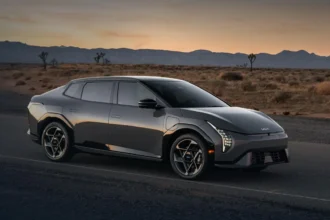Despite market uncertainties, electric vehicles (EVs) continue to gain strong momentum in the global automotive landscape, according to new data from the International Energy Agency (IEA). “Our data shows that, despite significant uncertainties, electric cars remain on a strong growth trajectory globally,” said Fatih Birol, IEA Executive Director.
The agency projects that EVs will account for one in four cars sold this year, following record sales exceeding 17 million units in the previous year. The first quarter of 2025 has already seen EV sales jump by 35 percent globally, setting the stage for continued expansion throughout the year.
Regional Market Dynamics Show Varied Growth Patterns
The global EV market is experiencing dramatically different growth rates across major regions. China leads with a remarkable 40 percent increase in sales, while Europe remains stagnant, and the United States shows a moderate 10 percent growth. According to the International Energy Agency, actual sales figures tell an even more striking story about market distribution:
- China dominates with approximately 8 million electric car sales in 2024, representing about 60% of the global market – this massive volume reflects both domestic demand and production capacity that exceeds other regions combined
- Europe follows with roughly 3.7 million electric car sales in 2024, accounting for around 20% of worldwide sales – despite early adoption advantages, European growth has plateaued amid changing incentive structures
- The United States lags significantly with about 1.4 million electric car sales in 2024, making up only 8% of global sales – this reflects both infrastructure challenges and consumer hesitancy despite growing model availability
- Emerging economies in Asia, Latin America, and Africa are showing promising growth with a 60% year-on-year increase – these markets represent future expansion opportunities as prices decrease
This uneven distribution highlights how regional policies, consumer preferences, and manufacturing capabilities are shaping the transition to electric mobility at different rates around the world.
Price Factors Creating Market Disparities
The affordability gap between electric and conventional vehicles varies dramatically across different markets. In China, two-thirds of electric cars sold were priced lower than their conventional equivalents, making them an economically attractive option for consumers. This pricing advantage stands in stark contrast to Western markets. Battery electric cars remain approximately 20 percent more expensive in Germany and 30 percent higher in the United States compared to similar conventional models.
Beyond purchase prices, the lower operating costs of EVs continue to support sales growth. Electric vehicles typically cost less to maintain and “fuel” with electricity than traditional gasoline or diesel vehicles. However, these long-term savings can be difficult for consumers to fully appreciate at the time of purchase, especially in markets where the initial price premium remains high.
China’s Manufacturing Dominance Reshapes Global Market
China has established itself as the undisputed leader in EV production and innovation. The country now accounts for over 70 percent of worldwide EV production, creating a manufacturing powerhouse that supplies both domestic and international markets. Chinese automakers are strategically investing in local production facilities across emerging markets to expand their global footprint.
The global trade in electric vehicles now accounts for almost one-fifth of total EV sales, showing how Chinese manufacturers are successfully exporting their products. This expansion is supported by competitive pricing strategies and political support that has helped Chinese brands gain market share even in regions traditionally dominated by established automotive companies.
Emerging Markets Embrace Electric Mobility
Electric vehicle sales in developing economies increased by more than 60 percent year-on-year, showing growing adoption beyond wealthy nations. This growth is particularly notable in parts of Asia, Latin America, and Africa, where affordability concerns had previously limited EV adoption but are now being addressed through various mechanisms.
The accelerating uptake in these regions is driven by a combination of falling prices, government incentives, and increasing model availability. As Chinese manufacturers target these markets with affordable options, electric mobility is becoming accessible to a broader range of consumers globally.
Policy Incentives Driving Global Adoption
Government support measures continue to play a crucial role in accelerating EV adoption, particularly in emerging markets. These incentives take various forms:
| Incentive Type | Implementation Examples | Market Impact |
|---|---|---|
| Financial Incentives | Purchase subsidies and tax exemptions that directly reduce upfront costs for consumers, making EVs more competitive with conventional vehicles | Significantly narrows price gaps, especially important in price-sensitive markets where even small differences affect buying decisions |
| Infrastructure Development | Government funding for expanding charging networks in urban centers, highways, and residential areas to address range anxiety | Removes practical barriers to adoption by ensuring drivers can easily find charging solutions for daily use |
| Non-Fiscal Benefits | Preferential parking access and congestion charge exemptions that provide everyday convenience advantages to EV owners | Creates ongoing value proposition beyond purchase price, particularly effective in congested urban environments |
| Manufacturing Support | Policies promoting local production of EVs and batteries through industrial incentives and technology partnerships | Builds domestic supply chains that reduce costs and create economic benefits beyond transportation |
Future Outlook Remains Strongly Positive
By the end of this decade, the International Energy Agency expects electric vehicles to represent more than two in five cars sold globally. This projection underscores the accelerating transition away from internal combustion engines toward electrified transportation. As manufacturing scales up and battery technology improves, the economic and practical advantages of EVs will likely continue to strengthen their market position worldwide.











